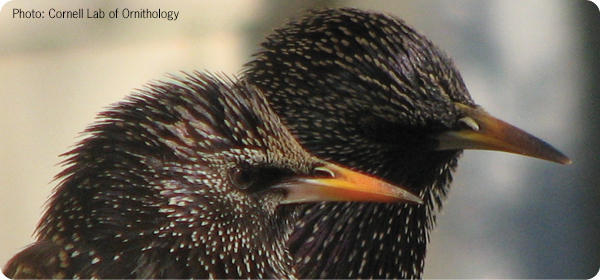Dealing With Starlings
These Flocks of Starlings are Driving Me Crazy!!
We know that Starlings and other blackbirds have been driving our customers crazy recently, so we wanted to make a little video of tips on how you can make your bird feeding systems starling resistant. Click HERE to watch the video!!
What's up with all these black birds taking over your feeders? During the winter it is more than likely that the European Starling has been dominating your feeders!
One key to providing food to the many different species of birds that visit your yard, is to offer a variety of foods, in a variety of feeders, spaced throughout your yard, at different levels. Sound complicated? It’s really not! Recognize that, like us, birds prefer certain foods, offered in different dishes, with comfortable seating, and with good company!
So how do you serve the right foods, in the correct serving dishes, and at a comfortable table, without inviting Mr. & Mrs. Starling? There are several solutions to keep these birds from monopolizing your dinner party!
The Menu
Birds have different energy requirements. Most of our backyard birds require high-fat, high-protein rich foods like sunflower, peanuts, safflower, thistle, suet, and mealworms. Only a few require carbohydrates like millet (Sparrows and Mourning Doves). You can be sure that none prefer milo and other fillers that are commonly found in commercial blends.
We know that European Starlings have a highly adaptable diet and eat a wide variety of foods, such as snails, worms, millipedes, and spiders, in addition to fruits, berries, grains, and seeds.
But did you know Starlings don’t care for Safflower Seed, Nyjer (thistle), Peanuts in the Shell, and Simply Suet?
Dishing It Out
 Safflower
Safflower
Safflower is only slightly smaller than sunflower so it will fit in a large variety of feeders. Cardinals love Safflower, and you’ll see other frequent visitors like House Finch, Chickadees, Titmice, Mourning Doves, and even the Downy and Red-bellied Woodpeckers. Rose-breasted Grosbeaks (who visit early spring love it too). Another great benefit to Safflower is that Squirrels and Raccoons typically don’t like it either!
- Since Cardinals love Safflower, and Starlings don’t, I prefer to serve it in a Tray Feeder, so that Cardinals can easily access it. You could also serve it in a Hopper Feeder (which is suitable for all birds) or a Tube Feeder (which Starlings have difficulty eating from due to their size/perch/portable access, but unfortunately so do Cardinals).
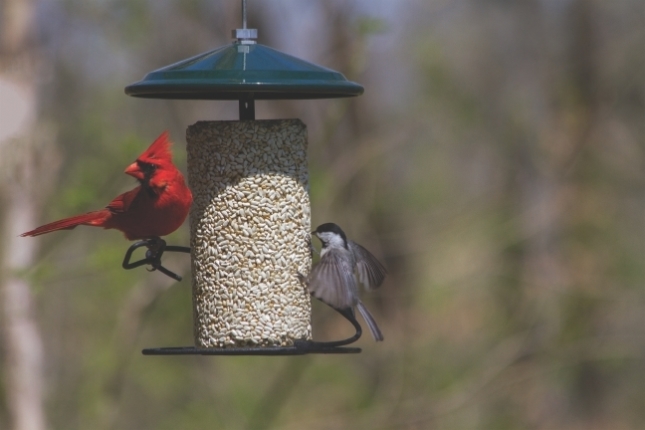
- If you are relatively new to feeding Safflower you may want to considering feeding it in its cylinder form. This compacted seed cylinder ensures that Starlings will not push out what they don’t like, but allow your other birds the ability to enjoy it from a Cylinder Feeder.
Nyjer/Thistle
Thistle is a favorite of your American Goldfinch who are here year around and incidentally do not like Safflower.
You’d also expect to see House Finch and the occasional Chickadee at your thistle feeder.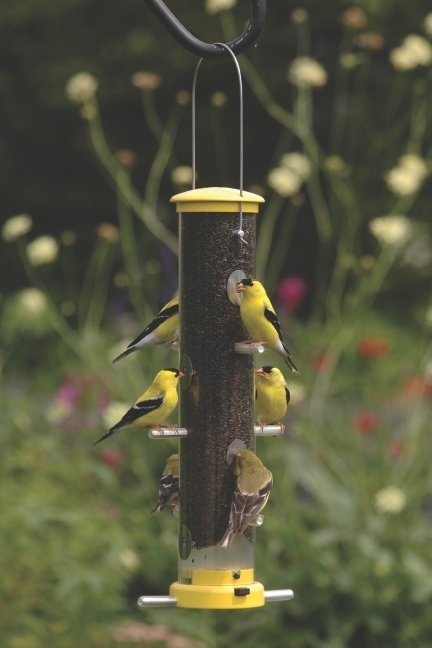
- Another winter visitor that loves thistle is the Dark-eyed Junco. This ‘snowbird’ is primarily black with a white belly. You often see them on the ground under your feeders, especially when it’s snowing! It’s difficult to feed from the ground because of Starlings and Squirrels, but offer Thistle in a covered ground feeder and you’ll see juncos galore!
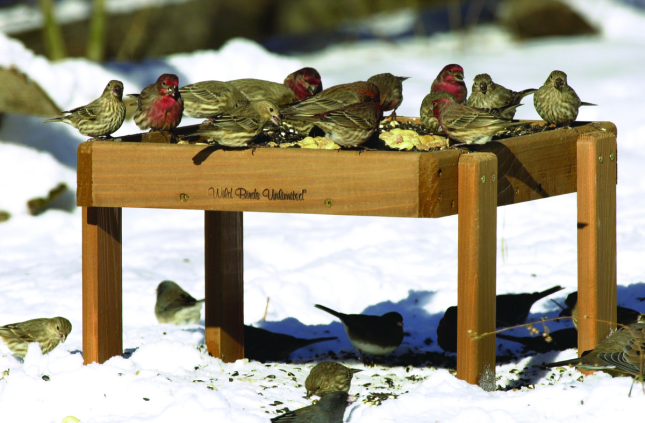
Peanuts in the Shell
Yes, squirrels love peanuts, but if you put a baffle on a peanut feeder you can watch Woodpeckers, Blue Jays, Tufted Titmice and other woodland birds enjoy this high-fat, high-protein food, with Starlings!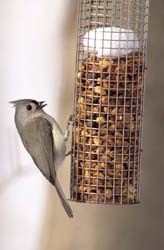
Simple Suet
Woodpeckers are the primary eaters of suet. When you offer Simply Suet (all suet, no nuts, bugs, or fruit) you will satisfy their energy needs and not the Starlings!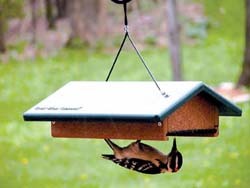
- A double whammy – feed the Simply Suet in an Upside-down Feeder. Starlings don’t cling well, and if they have to work at eating something they really don’t like, they are sure to leave it alone. Since Woodpeckers are natural acrobats, they’ll have no problem gobbling it up!
And Don’t Despair, You Can Still Feed the Good Stuff!
The innovative people at Wild Birds Unlimited have figured out other ways to keep Starlings out of feeders that contain your backyard bird’s favorite, high-fat, high-protein foods, like No-Mess Blend and Choice Blend.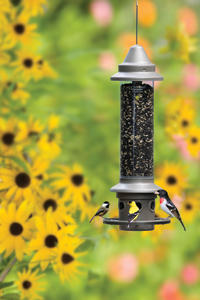
- The Eliminator: Not only does this feeder keep squirrels out, but the adjustable spring can be set to close on Starlings and allow access to only smaller birds. Adjust the spring to close the ports half way, add a weather guard, and you can still enjoy seeing Cardinals on this feeder.
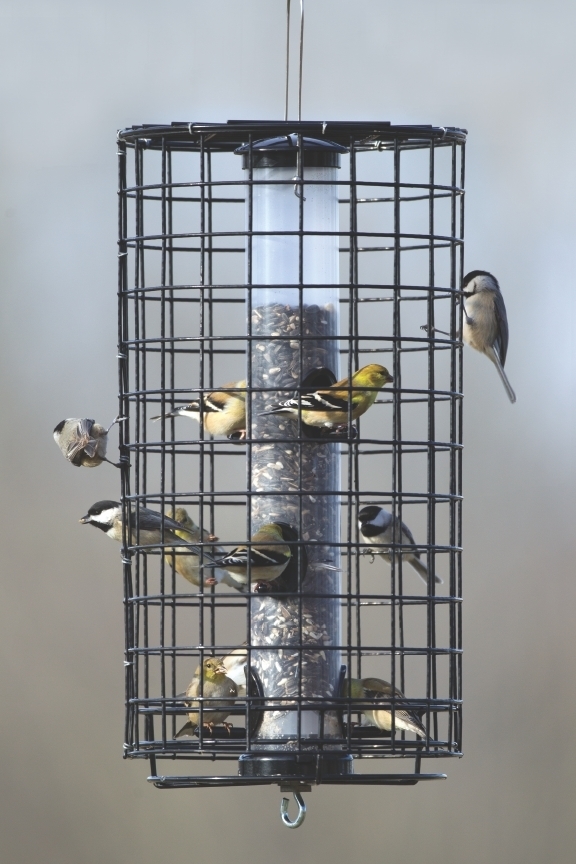
- Cages for Tube Feeders, Suet, Cylinder Feeders, Mealworms, & Bark Butter Bits: An investment in a cage for your current feeder will give you control when Starlings start showing up at your feeders. Cages keep out larger birds, including Cardinals, but give ample opportunity to the wide variety of desirable visitors.
Other Proper Etiquette Tips:
- Fill your feeders with just enough fresh food in the morning and then in the evening to be sure your "favorite" birds eat it before the Starlings find it (Starlings are late sleepers :)
- Avoid feeding corn in any form. This is sure to attract Starlings and other birds that can become invasive in your yard.
- Sound repellents and loud noises are only going to scare the Starlings temporarily. This method is not an effective means of keeping them out of your yard.



